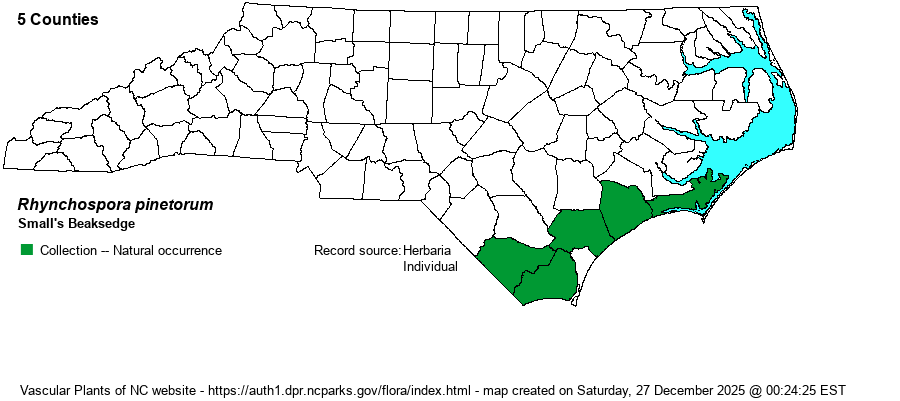| Section 5 » Family Cyperaceae |
Show/Hide Synonym
| taxonName | relationship | relatedTaxonName | relatedTaxonRefText | relComments |
|---|
|
| Rhynchospora pinetorum | = | Rhynchospora globularis var. pinetorum | Flora of North America (1993b, 1997, 2000, 2002a, 2002b, 2003a, 2004b, 2005, 2006a, 2006b, 2006c, 2007a, 2009, 2010) | | | Rhynchospora pinetorum | = | Rhynchospora globularis var. pinetorum | Godfrey and Wooten (1979, 1981) | | | Rhynchospora pinetorum | = | Rhynchospora globularis var. pinetorum | Kartesz (1999) | | | Rhynchospora pinetorum | = | Rhynchospora globularis var. pinetorum | Goetghebeur in Kubitzki (1998b). Distributions given for tropical America are largely derived from Thomas (1992). | | | Rhynchospora pinetorum | = | Rynchospora pinetorum | Small (1933, 1938) | | | Rhynchospora pinetorum | < | Rhynchospora globularis | Wunderlin & Hansen Flora of Florida (3) | | | Source: Weakley's Flora |
|
| Author | Britton & Small | |
| Distribution | Southern outer Coastal Plain only, known from just 5 counties.
Coastal Plain, NC to FL and eastern TX; West Indies. | |
| Abundance | Rare, to locally uncommon (where well-managed). The NCNHP database has 17 records, all extant, and many are in fair to excellent condition. | |
| Habitat | Wet pine savannas, especially where underlain by limestone or coquina. |
| Phenology | Flowering and fruiting July-September. | |
| Identification | Small's Beaksedge is closely related to R. globularis; it is told from that species by the seed bristles at least 2/3 the length of the seed body (vs. usually less than 1/2 the seed body length in R. globularis). | |
| Taxonomic Comments | In recent decades, this species has been split out from R. globularis. A synonym is R. globularis var. pinetorum.
Members of the genus Rhynchospora -- mainly called beaksedges but also called beakrushes -- are mostly Coastal Plain in distribution and are important members of our longleaf pine savannas, flatwoods, streamheads, depression ponds, Carolina bays, and beaver ponds. They vary from small and wiry to large and coarse. Keys concentrate on features of the achenes (seeds) and the shape and arrangement of the flower clusters (spikelets). The seeds may or not have bristles at their base; bristle number, length, and toothing are critical characters. Size and shape of the seed beaks is also critical. The drawings in Godfrey & Wooten (1979) are extremely helpful. The genus now includes Dichromena, the white-topped sedges. | |
| Other Common Name(s) | Many references still use Globe Beaksedge, but that is the common name generally in use for the "parent" species -- R. globularis. | |
| State Rank | S2 | |
| Global Rank | G5?T3T4 [G3G4] | |
| State Status | SR-T | |
| US Status | | |
| USACE-agcp | | |
| USACE-emp | | |

